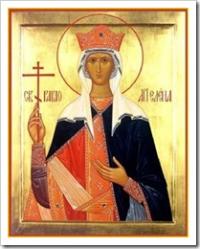
St Helena was born between 246 and 248 AD. It is thought that she was a Greek and came from Drepanum in the province of Bithynia in Asia Minor, modern Turkey. The authority for this is Procopius who wrote in the sixth century. Constantine renamed the city Helenopolis, which would suggest it was her birthplace, although there are other places named after her. It almost certain that she came from the lower classes of society. Fourth-century sources suggest that she had a humble background. Bishop Ambrose described her as a “stabularia”, which translates as “stable maid” or “innkeeper”. He described her as “good” to contrast her with the sexual laxness typical of that group of people. Both Geoffrey of Monmouth and Henry of Huntingdon claimed that she was a British princess, which accounts for the more than a hundred churches in England dedicated to her.
She probably met Constantius when he was stationed in Asia Minor. It is said that when they met they were wearing identical silver bracelets. Helena gave birth to the future Emperor Constantine I probably in 272. Constantius then divorced Helena to marry a wife more consonant with his rising status. Helena and her son were dispatched to the court of Diocletian at Nicomedia (modern Turkey). Helena never remarried and lived for some time in obscurity but remained close to her son who had a great affection for her.
Constantine became Emperor in 306 and his mother was brought back to public life in 312. She probably became a Christian at this time. She lived in Rome. Constantine appointed her Augusta, meaning great, a title given usually to the wives of Emperors. She appears in the Eagle Cameo, portraying Constantine’s family, probably commemorating the birth of Constantine’s son Constantine II in 316.
Helena was given access to the imperial treasury in order to locate the relics of the Christian tradition. In AD 326–328 Helena undertook a trip to Palestine. According to Eusebius of Caesarea, who was a contemporary of Constantine, Helena was eighty when she returned from the journey. He claims that she was responsible for the construction or beautification of the Church of the Nativity in Bethlehem and the Church of Eleona on the Mount of Olives. The Emperor Hadrian had built a temple, dedicated to Venus, over the supposed site of the tomb of Jesus near Calvary. Helena ordered the temple to be torn down and - according to the legend which that began at the end of the fourth century - recovered three crosses. The legend is recounted in Ambrose, On the Death of Theodosius, and by Rufinus and Gelasius of Caesaria, late fourth-century historians. Helena demanded solid proof that she had indeed found the true cross. A woman on the point of death was brought from the city. When she touched two of the crosses her condition did not change but on touching the third she suddenly recovered. This, Helena declared, was the true cross. Constantine ordered the building of the Church of the Holy Sepulchre on the site of the discovery. It was also claimed that Helena had found the nails of the crucifixion and she had one placed in Constantine’s helmet and another in the bridle of his horse. According to one tradition Helena also discovered Christ’s tunic and sent it to Trier. Other relics were dispatched to Cyprus where Helena spent some time. Helena left Jerusalem for Rome in 327 bringing large parts of the cross which, together with other relics, were stored in her palace’s private chapel, now the Basilica of Santa Croce in Gerusalemme (one of the seven pilgrim churches in Rome) where they can be seen today. This has been maintained by Cistercian monks.
Helena died in 330 with Constantine at her side. She was buried in the Mausoleum of Helena outside Rome on the via Labicana. Her sarcophagus is on display; however, her remains were moved in 1154 to Santa Maria Ara Coeli. Helena was renowned in her lifetime for her generosity to the poor and to whole communities. She endowed many churches.
St Helena, pray for us.